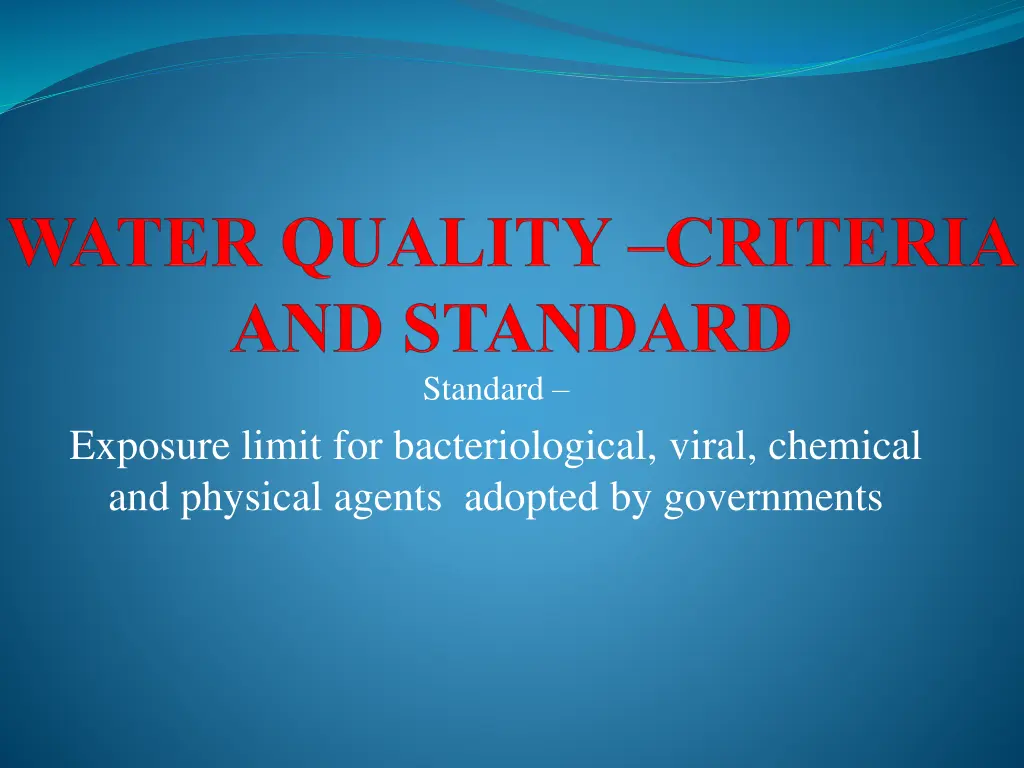
Water Quality Standards and Assessment Guidelines for Health and Safety
Explore the standard exposure limits for bacteriological, viral, chemical, and physical agents set by governments, as well as WHO guidelines for drinking water quality. Learn how controlling water standards is crucial for human and environmental well-being, covering acceptability aspects, microbiological, chemical, and radiological considerations. Delve into the importance of physical parameters like turbidity, color, taste, odor, temperature, and inorganic constituents such as chlorides, hardness, ammonia, pH levels, hydrogen sulfide, iron, and sodium in ensuring water purity and safety.
Download Presentation

Please find below an Image/Link to download the presentation.
The content on the website is provided AS IS for your information and personal use only. It may not be sold, licensed, or shared on other websites without obtaining consent from the author. If you encounter any issues during the download, it is possible that the publisher has removed the file from their server.
You are allowed to download the files provided on this website for personal or commercial use, subject to the condition that they are used lawfully. All files are the property of their respective owners.
The content on the website is provided AS IS for your information and personal use only. It may not be sold, licensed, or shared on other websites without obtaining consent from the author.
E N D
Presentation Transcript
Standard Exposure limit for bacteriological, viral, chemical and physical agents adopted by governments
WHO In 1993 vol.1 in 1996 of second edition of guidelines for drinking water quality Following variables 1-Acceptability aspects 2-Microbiological aspects 3-Chemical aspects 4-Radiological aspects
WHY CONTROL WATER STANDARD Health and survival of man and other organisms depends upon purity of water they used. Different measures are used to access and control water quality with varying degrees of relevalence and acceptability. Hence the need to adopt generalized methods of assessment and arbitrary standards of water quality.
ACCEPTABILITY ASPECTS PHYSICAL PARAMETERS 1- Turbidity-free from turbidity less than 5 nephelometric turbidity units (NTU) 2-Colour- free from color may be due coloured organic matter, metals as iron and manganese or highly colored industrial wastes up to 15 true coloured units (TCU) 3-Taste and odour-free from taste and odour 4- Temperature-Cool water more acceptable low temperature may decrease efficacy of treatment process and high temperature may enhances growth of microorganism
ACCEPTABILITY ASPECTS 2-INORGANIC CONSTITUENTS- 1-Chlorides-near to sea salinity of water is high 200 mg./L and maximum permissible limit is 600mg./L 2-Hardness of water taste threshold for calcium ion is 100-300mg./L even 200 mg./L may cause scale deposition and excessive consumption of soaps Soft water less than 100 mg/L corrosive to pipes 3-Ammonia-both ionized and non-ionized originates from metabolic, agricultural, industrial processes and disinfection with chloramine 0.2mg/L can cause failure of filters for removal of manganese cause taste and odour problems
ACCEPTABILITY ASPECTS 4-pH-to stop corrosion and incrustation in distribution system less than 7 cause severe corrosion and elevated level of lead and pH above 8 decrease in efficacy of chlorine disinfection process between 6.5-8.5 5-Hydrogen sulphide-0.05-0.1mg/L rotten eggs due to depletion of oxygen and reduction of sulphate by bacterial activity 6-Iron-ferrous iron oxidizes to ferric iron giving reddish brown color and promotes growth of iron bacteria deposit a slimy coating on pipe above 0.3mg/L stain laundry and plumbing fixtures 7-Sodium 200mg/L
ACCEPTABILITY ASPECTS 8- Sulphate-cause noticeable taste level below 250mg/L addition of calcium 270mg/L and magnesium sulphate 90 mg/L 9-Total dissolved solids- less than 600mg/L unpalatable greater than 1200mg/L 10-Zinc-undesirable astringent taste to water4mg/L above 5mg/L may appear opalescent and develop greasy film on boiling 11-Manganese-below 0.1mg/L above stain sanitary ware and laundry coating on pipes slough off as black precipitate
ACCEPTABILITY ASPECTS 12-Dissolved oxygen- depletion can encourage microbial reduction of nitrate to nitrite and sulphate to sulphite giving odour problem 13-Copper-increases to corrosion of galvanized iron and steel fittings above 1mg/L 14-Aluminium-excess0.2mg/L deposition of aluminium hydroxide floc and discoloration of water by iron
II-MICROBIOLOGICAL ASPECTS Bacteriological indicators-should not contain any micro- organism 1-Coliform organism-aerobic and facultative anaerobic ,gram-negative, non-sporing, motile and non-motile rods capable of fermenting lactose at 35- 37 degree C in less than 48 hours includes both fecal and non-fecal, Klebsiella aerogens chosen as indicator of fecal pollution due to presence in abundance in human intestine average person excrete 200-400 billion/day presence as fecal contamination easily detected by culture survive longer greater resistance to natural forces of purification
2-Fecal streptococci-much smaller in number than E.coli confirmatory evidence of recent fecal pollution 3-Cl.perfringens-regulaly in feces much smaller in number spores are capable of surviving longer time resist to chlorination presence suggest fecal contamination
VIROLOGICAL ASPECTS Free from any viruses disinfection with 0.5mg/L of free chlorine after contact period of 30 minutes at pH 8 is sufficient to inactivate virus
BIOLOGICAL ASPECTS Protozoa-Entamoeba histolytica, Giardia supp. And rarely Balantidium coli through human or animal should be free from protozoa Helminthes-round worm and flat worm guinea worm and human schistosomes Free-living organisms fungi and algae
III CHEMICAL ASPECTS INORGANIC CONSTITUENTS- 1-Arsenic-through dissolution of minerals and ores, industrial effluents and atmospheric deposition. 0.01mg/L 2-Cadamium-used in steel and plastic industry and batteries less than 1 micro gram /L accumulates in kidney biological half life is 10-35yrs guideline value is 0.003micro gm/L 3-Chromium-guideline value is 0.05 mg/L 4-Cyanide-effects on thyroid and nervous system on long term consumption of inadequately processed cassava having high level of cyanide guideline value is 0.07mg/L
5-Fluoride-1.5 mg./L diet contain fish and tea and toothpaste with fluoride high fluoride may leads to fluorosis low leads to dental carries 6-Lead-due to dissolution from natural sources but primary from plumbing systems depend on several factors pH, temperature, water hardness and standing time of water with soft acidic water most plumbo-solvent
7-Mercury-in inorganic form in surface and ground water less than 0.5 mg/L kidney main target organ Guideline value is 0.001mg/L Nitrate and nitrite- naturally occurring ions part of nitrogen cycle Nitrate up to 50mg/L due to intensification of farming practices. Guidelines value is 50mg/L and 3mg/L for nitrite Concentration of nitrate + concentration of nitrite =<1 Guide line value of nitrate Guide line value of nitrite 9-Selenium-guide line value 0.01mg/L toxicity manifested in nail, hairs and liver
CHEMICAL ASPECTS.. ORGANIC CONSTITUENTS- Polynuclear aromatic hydrocarbons-from variety of combustion and pyrolysis sources Constituents Benzo, Pyrene to be carcinogenic in mice Close association with suspended solids recommended level reduced to minimum PAH
Contamination of water with PAH not during water treatment or distribution use of coal-tar-based for pipe lining and coating on storage tank should be discontinued In case of contamination with PAH specific compound and source of contamination identified as carcinogenic potential varies Pesticides-chlorinated hydrocarbons and derivatives, persistent herbicides ,soil insecticides, pesticides Recommended guideline value
Pesticide Upper limit of concentration (micro gm./L) Aldrin/dieldrin 0.03 Chlordane 0.2 DDT 2 2,4-D 30 Heptachlor and heptachlor epioxide 0.03 Hexachlorobenzene 1 Lindane 2 Methoxychlor 20 Pentachlorophenol 9(P)
Drinking water consumption and body weight Per capita consumption daily 2 litres Variations due to climate, physical activity and culture
TDI-Tolerable daily intake-an estimate of the amount of a substance in food or drinking water mg/kg or micro gm/kg. of body weight that can be ingested daily without health risk ADI-Acceptable daily intake- No-observed-adverse effect level (NOAEL)lowest observed dose of substance at which no adverse health effect Lowest-observed- adverse -effect level(LOAEL)- lowest observed dose at which there is detectable adverse effect Uncertainty factor(UF)-
RADIOLOGICAL ASPECTS Effects called somatic Malignant diseases most important delayed somatic effect Effect occurring rather than its severity regarded as function of dose without threshold stochastic effect Severity of effect varies with dose-non-stochastic effect The aim of radiation protection to prevent harmful non- stochastic and to reduce the probability of stochastic to a acceptable Radioactivity should be within safe limits as low as reasonably possible Proposed guide line gross alpha activity 0.1Bq/L gross beta activity 1.0 Bq/L
SURVEILLANCE OF DRINKING WATER QUALITY 1-Approval of new sources 2-Watershed protection 3-Approval of construction and operating procedure of waterworks Disinfection of the plant and distribution system after repair or interruption of supply Periodic flushing programme and cleaning of water storage facility
Certification of operators Regulation of chemical substances used in water treatment cross connection control, back flow and leak detection control 4-sanitary surveys 5-monitoring programmes, including provision for central and regional analytical laboratory services 6-development of codes of practice for well construction, pump installation and plumping 7-inspection quality control in bottled-water and ice manufacturing operations
ELEMENTS OF SURVEILLANCE PROGRAMME 1- sanitary survey-on the spot inspection and evaluation by qualified person for detection and correction of faults and deficiencies 2-with thoroughness of surgical operation with similar aseptic precautions should be carried out by competent and trained personnel accordance with WHO guidelines or ICMR Manual of standard of Quality for drinking supplies
3- BACTERIOLOGICAL SURVEILLANCE- 1-A-PRESUMPTIVE COLIFORM TEST- 1-MULTIPLE TUBE TEST- estimating most probable number(MPN) in 100 ml. of water by inoculating sample water (0.1,1.0, 10, 50 ml.) into tubes of McConkey s Lactose Bile Salt Broth with bromocresol as an indicator incubated for 48 hours from number of tubes showing acid and gas estimate of MPN of coliform organism from statistical table
CONFIRMATORY TEST: By sub-culturing each presumptive positive tube in two tubes of brilliant green bile broth, one of which is incubated at 370C for 48 hours and other incubated at 440C for testing for indol production at 440C.
2- MEMBRANE FILTRATION TECHNIQUE: A measured volume of sample is filtered through a membrane specially made up of cellulose ester. All bacteria in water retained on the surface of membrane and by inoculating the membrane face upwards on suitable media and at appropriate temperature, it is possible to count the colonies and obtain results within 20 hour.
2-THE DETECTION OF FAECAL STREPTOCOCCI AND Cl. PERFRINGENS: Presence of fecal streptococci and Cl. Perfrigens useful confirmatory evidence of fecal pollution
3- COLONY COUNT: Colony count on nutrient agar at 370C and 220C. A single count is of little value but count from same source at frequent interval is of value
RECOMMENDED PLATE COUNTS Water at the point of consumption days at 370C Plate count after 2 Plate count after 3 days at 220C Disinfected 0 20 Not-disinfected 10 100 Bacterial plate count on yeast extract agar after incubation at 220C for 7 days
4- BIOLOGICAL EXAMINATION: May contain microscopic organism algae, fungi, yeast, protozoa, rotifers, crustaceans, minute worms etc. planton. Plantons produced objectionable taste and odors. Degree of pollution assessed qualitatively and quantitatively by noting type and number of organism.
5- CHEMICAL SURVEILLANCE: Tests for pH, color, turbidity, chlorides, ammonia, chlorine demand and residual chlorine Test for iron and manganese when these substances present in raw water. Analysis for toxic metals, pesticides persistent organic chemicals and radioactivity.

